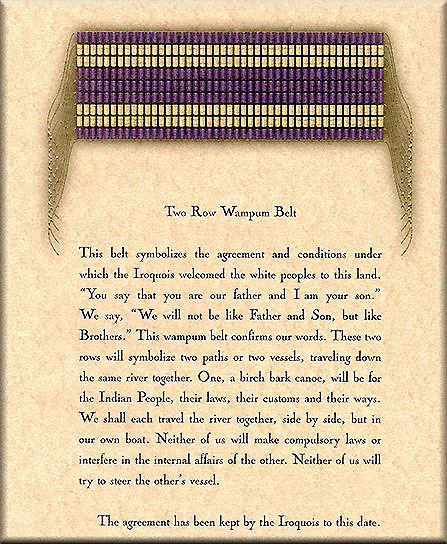The Covenant Chain
![]()
To understand the political relationship between the Iroquois Confederacy and Colonial America, requires an understanding of the Covenant Chain concept. The Covenant Chain was an ongoing set of councils and treaties between the English colonies in North America and the Iroquois Confederacy. These treaties and councils covered such contentious matters as trade, settlement, and the resolution of episodes of violence between Colonial-settlers and the Iroquois. The Covenant Chain operated from the late 17th century until the middle of the 1750s. During most of its operation, New York took the lead in representing the English colonies because most negotiations took place in the Mohawk Valley .
The Covenant Chain broke down when representatives of the different colonies could not agree among themselves on a common position to take when meeting with representatives of the Iroquois Confederacy. After the breakdown in the Covenant Chain, the English Government stopped allowing local officials to negotiate state matters with the Iroquois and took a much more active role; dealing with the Confederacy as a sovereign Nation.
![]()
The Iroquois Confederacy, also known as the Haudenosaunee, began the Covenant Chain in 1692. This treaty is recorded in the Two Row Wampum belt called the Guswenta.
 |
Gustwenta is about four feet long and has two dark rows of beads to show the two governments as separate but equal. One row represented the white man's ship that contained all of his culture, religion, and laws. The other row represented the Iroquois in their canoe, with all of their traditions, beliefs, and laws. It was called the Covenant Chain because the metaphor for that relationship was a silver chain that tied the white man's ship and the Iroquois canoe to the Tree of Peace. An actual silver chain was made to symbolize their agreement. The three links of that chain were said to represent peace and friendship forever, the basic themes of all Iroquois treaties. This is also the first written treaty to use the famous phrases: "as long as the sun shines upon the earth; as long as the waters flow; as long as the grass grows green, peace will last."
As the dominant European powers in North America changed, the Covenant Chain was continually renewed with the Haudenosaunee. In 1755, William Johnson renewed the concept of the Covenant Chain at a council with the Iroquois, restating the symbolic meaning of that agreement, calling it the "Covenant Chain of love and friendship" He stated that the chain has been attached to the immovable mountains and nearly every year the British and Iroquois would gather to "strengthen and brighten" the chain. Treaty gatherings, such as the one that occurred at Albany in 1754, served to "strengthen and brighten" the covenant chain.
Learning Aids | Great Law of Peace | US Constitution | Timeline | Works Cited
© 1 October 2001, Portland State University